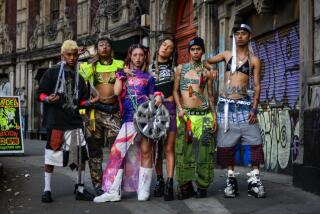STYLE: Leaders of the Pack : Southern California Trendsetters: Portraits From the Creative Edge : Boy Meets Car: Tom Matano
- Share via
Growing up in 1950s Tokyo, Tsutomo Matano marveled at his grandparents’ Parker pens, GE refrigerator and other golly-gee-whiz gadgets from America. But the tail-fin Cadillacs left the biggest impression, sparking a lifelong love affair with the automobile. Decades later, he’s car-crazy still, designing cars and running perhaps the most successful automotive design studio in Southern California.
Now 46 and known as “Tom,” Matano is executive vice president of design at Mazda’s research and development facility in Irvine, where he and his staff of 28 have originated roughly half of Mazda’s lineup--an impressive record considering that they compete against two in-house design teams in Japan. Aside from conceiving the Miata, RX-7, MX-6 coupe, MPV minivan, Navajo sport/utility vehicle and B-Series trucks, they also contributed to the Millenia, the luxury sedan that goes on sale next month, complete with ergonomically correct radio controls.
The jaunty little Miata, though, will probably always top Matano’s resume. In 1983, he set out to re-create the sports car he never had the chance to own and wound up with what Robert Cumberford, automotive design editor for Automobile magazine, calls “an enormous success.” Of the ragtop’s well-modulated, best-selling curves, Matano says: “The surface has emotional romance and sportiness people can relate to. It’s simply fun.”
The road to Mazda began when Matano earned a degree in analysis engineering. “All those time-and-motion studies were too cold and scientific,” he recalls, so he came to L.A. in 1970 to study at Art Center College of Design. After stops at Oldsmobile in Detroit, General Motors in Australia and BMW in Germany, he headed back to California car heaven.
Along the way, Matano has remained passionate about his work, allowing masterpieces of the past to serve as his muses for the future. “While we were doing the RX-7, we had a Ferrari 275GTB in here,” he says. “I wanted my designers to not feel intimidated by a classic muscle car.”
Good design is influenced by what came before, he explains, yet it means giving soul to a new machine: “As long as the users are human, the shape should be organic, natural. It should be in touch with the human element.”






